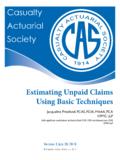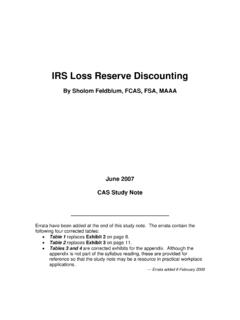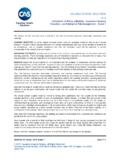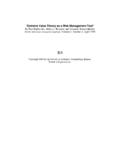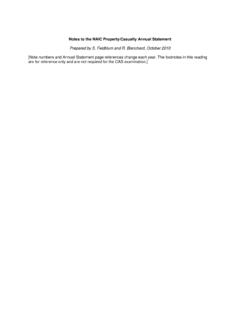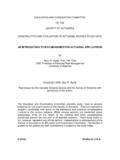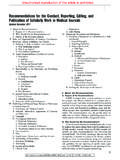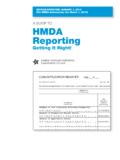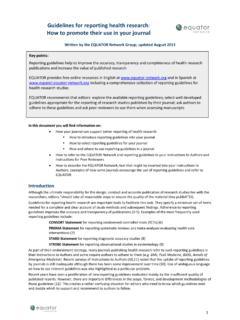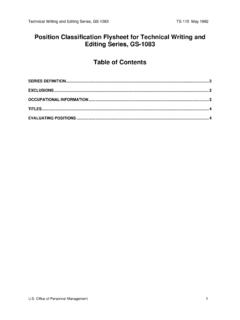Transcription of Financial Reporting Through the Lens of a Property ...
1 Financial Reporting Through the lens of a Property /Casualty Actuary Kathleen C. Odomirok, FCAS, MAAA. Liam M. McFarlane, FCIA, FCAS. Gareth L. Kennedy, ACAS, MAAA. Justin J. Brenden, FCAS, MAAA. EY. Casualty Actuarial Society, 2014. Financial Reporting Through THE lens OF A Property /CASUALTY ACTUARY. Foreword FOREWORD. EY was retained by the Casualty Actuarial Society (CAS) to write a new text on Financial Reporting and taxation as it affects reserving and statutory Reporting for use in the CAS basic education process. The CAS had two key objectives for this text: 1. Replace a number of readings that existed on the CAS Syllabus of Basic Education as of 2011 with a single educational publication. 2. Refine the content of the syllabus material to focus on Financial accounting and taxation topics that are of particular relevance to the Property /casualty actuary.
2 The CAS specified that the new text would focus on the learning objectives contained within the syllabus as of 2011. This publication has been prepared from an actuary's lens , highlighting those areas of Financial Reporting and taxation deemed to be relevant by the CAS Syllabus Committee and the authors of this text. The learning objectives contained within the 2011 syllabus provided the underlying direction of the content contained herein. The Exam 6 learning objectives and examination material may change over time, and thus, the content of this publication may need to be updated. This text does not represent the position of EY or the authors with respect to interpretations of accounting or tax guidance. Nor is this text intended to be a substitute for authoritative accounting guidance issued by the National Association of Insurance Commissioners (NAIC), American Institute of Certified Public Accountants (AICPA), Financial Accounting Standards Board (FASB), Governmental Accounting Standards Board (GASB), Securities and Exchange Commission (SEC), Internal Revenue Service (IRS), Canadian Institute of Chartered Accountants (CICA), or any other regulatory body.
3 Authoritative guidance from regulatory bodies trumps the writings contained herein. Furthermore, accounting standards are continuously evolving. As a result, readers of this text should be aware that the accounting standards referenced in this publication may have changed since the time of writing. The CAS. may request that this publication be updated to reflect such changes. While the authors of this publication have taken reasonable measures to verify references, content and calculations, it is possible that we may have inadvertently missed something. We would appreciate being informed of any inaccuracies so an errata sheet(s) may be issued and/or future editions of this publication may be corrected. 1. Financial Reporting Through THE lens OF A Property /CASUALTY ACTUARY. Acknowledgements ACKNOWLEDGEMENTS. The authors of this publication would like to thank the CAS Syllabus Committee for its review of this publication and feedback provided.
4 Special thanks goes to Sarah McNair-Grove, Laura Cali, George Levine and Michel Trudeau who reviewed the various drafts, and Wendy Germani who spent countless hours creating and editing the Annual Statement excerpts for Fictitious Insurance Company. The amount of personal time spent by these individuals demonstrates their tremendous dedication to the actuarial profession. The authors would also like to acknowledge those individuals within EY who assisted us by creating certain content, tables and exhibits and performing editorial reviews. These individuals include John Dawson, Aleksandra Orlova, Cosimo Pantaleo, Doru Pantea, Anita Park, Kishen Patel, Yan Ren, Christopher Scudellari, Heidi Sullivan and Jay Votta. Particular credit goes to Adam Walter, who created the Risk-Based Capital calculations for Fictitious Insurance Company. We would also like to thank Dave Heppen, member of the American Academy of Actuaries Committee on Property and Liability Financial Reporting , for reviewing the sections on the Statement of Actuarial Opinion and Actuarial Opinion Summary.
5 Finally, the authors of this text would like to express their deep gratitude to the actuarial professionals who have invested their time writing publications for the CAS examination process. Although this publication will serve as a consolidation of many of the papers formerly on the Exam 6 Syllabus, we acknowledge the significant contributions that those papers have made in advancing the actuarial profession, as well as the knowledge of the authors of the text. In preparing Financial Reporting Through the lens of a Property /Casualty Actuary, we relied extensively on the following publications and resources: PUBLICATIONS. 2011 Insurance Expense Exhibit. Best Company, Best's Key Rating Guide, Property /Casualty, United States & Canada, . 2010. Blanchard, Ralph S., Basic Reinsurance Accounting Selected Topics, CAS Exam Study Note, Arlington, VA: Casualty Actuarial Society, October 2010, 2.
6 Financial Reporting Through THE lens OF A Property /CASUALTY ACTUARY. Acknowledgements Cantin, Claudette, and Phillippe Trahan. Study Note on the Actuarial Evaluation of Premium Liabilities, Journal of Actuarial Practice, 1999: 7, pp. 5- 72, American Academy of Actuaries Committee on Property and Liability Financial Reporting , Statements of Actuarial Opinion on P&C Loss Reserves, Washington, DC: American Academy of Actuaries, December 2010. Feldblum, Sholom. Completing and Using Schedule P, CAS Exam Study Note, Arlington, VA: Casualty Actuarial Society, 2003, 8th Edition, Feldblum, Sholom. Reinsurance Accounting: Schedule F, CAS Exam Study Note, Arlington, VA: Casualty Actuarial Society, 2003, 8th Edition, Feldblum, Sholom. Computing Taxable Income for Property -Casualty Insurance Companies, . CAS Exam Study Note, Arlington, VA: Casualty Actuarial Society, 2007, pp.
7 1-13, Feldblum, Sholom. Federal Income Taxes and Investment Strategy, CAS Exam Study Note, Arlington, VA: Casualty Actuarial Society, 2007, pp. 1-12, Feldblum, Sholom, The Insurance Expense Exhibit and the Allocation of Investment Income, . CAS Exam Study Note, Arlington, VA: Casualty Actuarial Society, May 1997, Feldblum, Sholom, IRS Loss Reserve Discounting, CAS Exam Study Note, Arlington, VA: Casualty Actuarial Society, 2007, pp. 1-13, Insurance Accounting and Systems Association, Property -Casualty Insurance Accounting, 8th ed., 2003. MSA Research Inc., MSA Report on Property & Casualty, Canada, 2010. National Association of Insurance Commissioners, Accounting Practices and Procedures Manual, 2011. National Association of Insurance Commissioners, NAIC Insurance Regulatory Information System (IRIS) Ratios Manual, 2011. National Association of Insurance Commissioners, Official 2011 NAIC Annual Statement Blanks, Property and Casualty, 2011.
8 3. Financial Reporting Through THE lens OF A Property /CASUALTY ACTUARY. Acknowledgements National Association of Insurance Commissioners, Property and Casualty Risk-Based Capital Forecasting and Instructions, 2011. Steeneck, Lee R., Commutation of Claims," CAS Exam Study Note, Arlington, VA: Casualty Actuarial Society, 1998, pp. 1-26, Troxel, Terrie T., and George E. Bouchie, Property -Liability Insurance Accounting and Finance. 3rd ed. Malvern, PA: American Institute for Property and Liability Underwriters, 1990. RESOURCES. Actuarial Standards Board, Canada, Website of Office of the Superintendent of Financial Institutions, MCT effective January 1, 2012. The Canadian Annual Statement Blank P&C-1. Website of Canadian Institute of Chartered Accountants, Canadian Institute of Actuaries, Dynamic Capital Adequacy Testing, Educational Note, November 2007.
9 4. Financial Reporting Through THE lens OF A Property /CASUALTY ACTUARY. Table of Contents TABLE OF CONTENTS. Part I. Introduction ..7. Chapter 1. Financial Reporting in the Property /Casualty Insurance 7. Chapter 2. Relevance of Financial Reporting to the Actuary .. 11. Chapter 3. Overview of this Publication .. 13. Part II. Overview of Basic Accounting Concepts ..17. Introduction to Part II .. 17. Chapter 4. Primary Financial Statements .. 18. Chapter 5. Key Accounting Concepts .. 21. Part III. SAP in the : Fundamental Aspects of the Annual Statement ..22. Introduction to Part III .. 22. Chapter 6. Introduction to Statutory Financial Statements .. 23. Chapter 7. Statutory Balance Sheet: A Measure of 24. Chapter 8. The Statutory Income Statement: Income and Changes to 39. Chapter 9. Capital and Surplus Account .. 54. Chapter 10. Notes to Financial 59.
10 Chapter 11. General Interrogatories .. 73. Chapter 12. Five-Year Historical Data 80. Chapter 13. Overview of Schedules and Their Purpose .. 90. Chapter 14. Schedule F .. 107. Chapter 15. Schedule P .. 140. Part IV. Statutory Filings to Accompany the Annual Statement ..188. Introduction to Part 188. Chapter 16. Statement of Actuarial Opinion .. 189. Chapter 17. Actuarial Opinion Summary Supplement .. 200. Chapter 18. Insurance Expense Exhibit .. 204. Chapter 19. Risk-Based 227. Chapter 20. IRIS Ratios .. 286. 5. Financial Reporting Through THE lens OF A Property /CASUALTY ACTUARY. Table of Contents Part V. Financial Health of Property /Casualty Insurance Companies in the ..289. Introduction to Part 289. Chapter 21. Measurement Tools .. 290. Part VI. Differences from Statutory to other Financial /Regulatory Reporting Frameworks in the.

